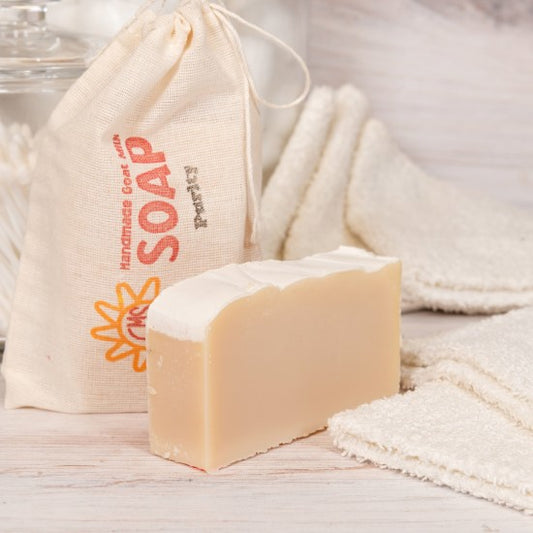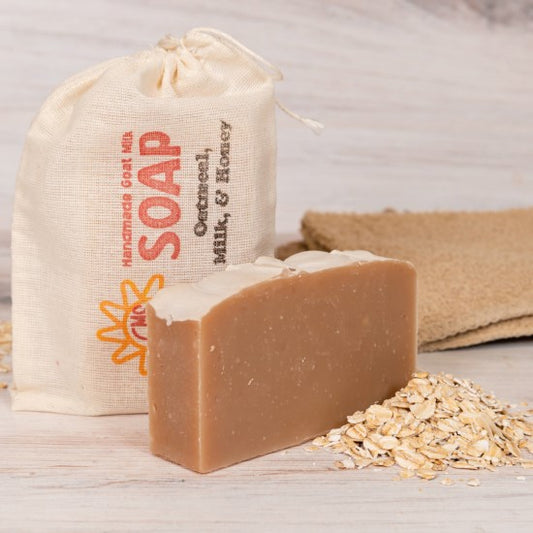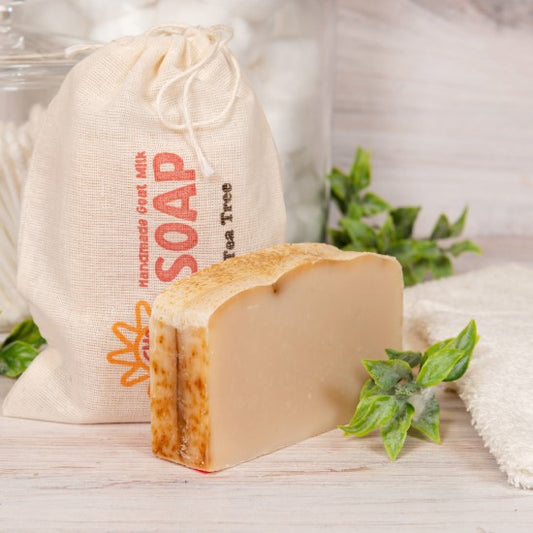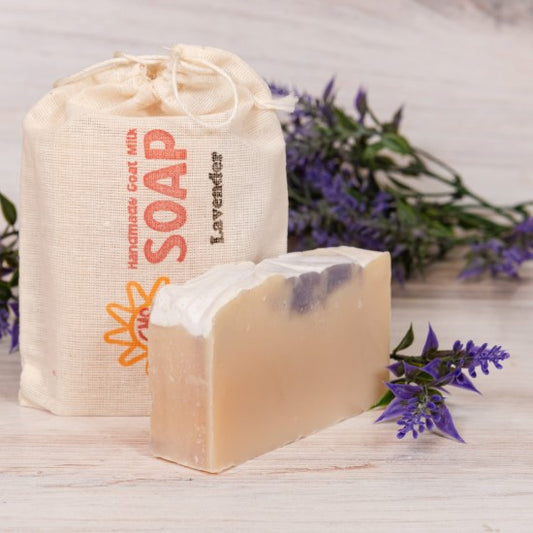About the Goats
At Goat Milk Stuff, we love our goats! We raise both Alpine and Nigerian Dwarf dairy goats. You can see our goats (and even buy some) at our Goat website.
Every one of our goats has a name. They will actually answer to their name if they aren't being stubborn! And each goat is very loved. They are curious, entertaining, and can be quite opinionated. Each goat has a personality, and you can definitely tell which goats the children have spoiled.
They take a lot of work, but we definitely think that life is better with goats.
What Type of Goats do You Have?
We raise two breeds of dairy goats on our farm. We've been raising Alpine Dairy goats since 2008. We love them because they are curious, friendly, and come in many different colors. Alpines also produce a lot of milk. They have kids every Spring (February - May).
We also have a herd of Nigerian Dwarf goats. They are a miniature dairy goat and can breed year-round.
How Many Goats Do You Have?
The number of our goats varies greatly throughout the year as kids are born and sold. The Alpine herd has grown roughly as follows:
- 2014: 16 milkers, 30 kids
- 2015: 40 milkers, 72 kids
- 2016: 60 milkers, 104 kids
- 2017: 80 milkers, 149 kids
- 2018: 96 milkers, 202 kids
- 2019: 122 milkers, 190 kids ("milked through" 32 goats)
- 2020: 112 milkers, 220 kids
Our Nigerian herd is still relatively small, especially in comparison to the Alpines. We're still fairly new to having Nigerians and are growing the herd as we work to create our ideal herd.
- 2017: 6 milkers, 14 kids
- 2018: 9 milkers, 17 kids
- 2019: 37 milkers, 87 kids
- 2020: 23 milkers, 63 kids (as of 7/8/20)
 In 2015, we started making and selling cheese, gelato, yogurt, and milk to on-farm visitors. As that demand grew, so did the number of goats.
In 2015, we started making and selling cheese, gelato, yogurt, and milk to on-farm visitors. As that demand grew, so did the number of goats.
But with the 2020 pandemic, for everyone's safety, we closed the farm to visitors as we focused on online sales. People always need good soap. But with a pandemic, people have become focused on extra hand-washing. This has highlighted the importance of using natural Goat Milk Soap that won't dry out your skin.
As a result, we sold a lot of our goats. While we will miss them, their new owners love their new family members. The pandemic initiated a significant decrease in the size of the Alpine herd for 2021.
Why Did You Get Dairy Goats?
When we moved to Indiana, we really wanted to homestead. We wanted the children to eat healthy food. We wanted the children to play outside in the sunshine. And we wanted them to learn how to work hard.
Gardening and planting an orchard were the easy parts of homesteading. We'd done that for years. Farm animals were something totally different. We had owned two horses when we lived in Virginia before our children were born. While we loved them, we knew how much work they were.
I really wanted both chickens for healthy eggs and dairy goats for healthy raw milk.
But Jim was hesitant to let us have farm animals and decided that we couldn't buy chickens or goats. But when a neighbor asked us to take his chickens for free since he couldn't keep them, we ended up with chickens.

Jim now calls chickens the "gateway animal". That's because shortly after the chickens arrived, we added more animals. First rabbits, then turkeys, and finally dairy goats joined the farm.
The dairy goats are a special part of our life. Not only do they can provide us with fresh, raw goat milk, but they regularly make us smile!
How Many Dairy Goats Did You Start With?
We started raising goats in 2005 with two nubians goats - Melody and Sassy. They were pregnant (so was I) and I was so excited. They weren't supposed to have their babies until March. Indigo was born (an intentional home birth) in February. The next day, Jim came running into the house to announce, "Sassy is having her babies!"
Nobody but me had a clue what to do (and my knowledge only came from the books I had read). We were totally unprepared. But I gathered up my supplies and headed out to the barn.
Sassy was a champ and delivered a doeling and buckling with ease. We fell in love with baby goats. And when we started milking Sassy a few weeks later, we fell in love with the goat milk as well.
Melody went into labor in March. While it wasn't a happy outcome, we learned so much about dairy goats during the experience. And we became deeply committed to being the best goat farmers we could be.
Over the next few years, we added a motley crew of goats to our herd - we tried saanens and lamanchas and more nubians. None of them were great goats, but we were learning.

And then in 2008, we made a great decision. As painful as it was to say good-bye, we sold all of our original goats. We started over with 2 excellent Alpine goats - Victoria and Dayton. And from there we've built our herd into what it is today.
Why Raise Alpine Dairy Goats?
We raise Alpine dairy goats for several reasons. We love their ability to milk. Our best goats will give over two gallons a day at peak and that is a lot of milk for a dairy goat.
We also love their temperaments. They are very friendly and curious. Unlike some goats, they aren't convinced you're out to kill them every time you make a change in the barn!
But as silly as this sounds, one of our favorite traits about Alpines is that they come in different colors. There are some very good breeds out there, but they're all the same color. And to me, that's just boring. I have a lot of fun wondering what colors will be born every year!
When Did You Start Raising Nigerian Dwarf Goats?
In 2016, we added a small herd of Nigerian Dwarf miniature dairy goats to the farm. The Alpines are seasonal breeders, but the "Nigies" are able to breed year-round.
We keep this herd so that we can offer Baby Goat Experiences year-round. Since not everyone can visit when the Alpines are little, this gives more people a chance to love on baby goats!

But for now, they're super fun to just watch and snuggle!
Who Milks the Goats?
It's a team effort. There are 14 milkings that need to be covered every week. The schedule changes depending on what is happening on and off the farm each week.
When we first got our goats, I was the one who did all the hand milking. Colter then took over in 2007. As the herd grew, more boys started helping with the milking. Then the girls learned. The children are able to milk from a young age.
But the more goats we milked, the more it became the boys' job. We have 5 milk stands for the 5 boys. Goats are creatures of habit so each boy had their own milk stand and their own goats to milk. This was super helpful because each boy knew their goats really well. They could immediately tell if a goat wasn't feeling well.
How Often Do You Milk the Goats?
We milk the goats twice a day - once in the morning and once in the evening. We milk each goat for about 10 months of the year. We usually start milking in February or March when the babies are born. We finish milking ten months later in December or January. The goats are not milked for the last two months of their pregnancies so they can grow their babies.
How Do You Milk the Goats?
Up until May 2016, the boys milked the goats by hand through a filter and into a stainless steel bucket. But at that point, they were hand milking 64 goats. Even split between 5 boys, this was a lot of work. The boys were able to keep up with it. But it was impossible for us to go on vacation or get a day away. It's not exactly easy to get somebody to milk 64 goats for you!
And so we made the decision to move to machine milking. This was a really difficult decision. Not only was it expensive, but the boys really liked hand milking. Yes, machine milking is faster and requires less effort, but my boys don't mind effort. And they like being hands-on with the goats at milking time.

So (as always) a lot of prayer and discussion went into the decision. The boys could decide to continue to grow Goat Milk Stuff and milk more goats. Or they could sell some goats and continue to milk by hand. And when it was framed that way, they all agreed moving to machine milking was the only viable solution.
Training the goats to machine milking was quite the chore. The machine milking system is very noisy and the goats were not sure what was going on. They definitely didn't want to stick their head in the gate at first. They hadn't yet realized there was food on the other side! But within a few days (or weeks depending on the goat) they had it all figured out. Now they go into the machine milking parlor without any hesitancy.
With the machine milking system, we can milk 16 goats at a time. We first clean the udders and then we attach the inflations. The goat milk travels through stainless steel piping. It goes directly into a stainless steel, bulk, milk-holding tank. It is then chilled to below 40 degrees in a matter of minutes. This produces milk that doesn't taste "goaty" at all.
Only healthy goats are milked in this system. If a goat just had a baby or if a goat is sick, they are hand milked.
When Does a Goat Start Giving Milk?
Goats start giving milk when they've had babies of their own. We breed the young Alpine does when they are about 7 months old and at least 70 pounds. They have a five month gestation and kid around their first birthdays. We wait a bit longer on the Nigerians so that they can mature and get bigger.
What is Kidding Season?
Nigerian Dwarf goats have their kids throughout the year. But Alpines are seasonal breeders. This means they come into heat in the fall and have their kids in the spring. Kidding season is when all the Alpine baby goats are born.
Kidding season is the craziest and best time of year here on the farm. We are on 24/7 kid watch and take shifts in the barn watching for signs of labor. Goats are like people - most of them can deliver without any difficulty. But they do occasionally have problems and we want to be there to help the delivery go safely for both Mom and kids.
We first check to make sure the kids are positioned properly. And then we assist the mom in delivering her babies. Because our goats often have multiples, this helps keep everyone alive and safe. We are very proud of the number of live births and healthy moms that we are able to achieve.
Why Do You Bottle Raise Your Baby Goats?
There is a goat disease called CAE that is passed to baby goats through their mother's colostrum and milk. We started bottle-raising because we wanted to guarantee that we had a CAE-free herd.
We discovered that bottle babies are a lot healthier, happier, and friendlier. We can also monitor them to make sure they are getting enough goat milk. We give them as much milk as they want when they are being bottle-raised. They don't have to compete with siblings to get their share of mom's limited milk supply.
The babies are also able to go to their new homes sooner because they can be fed with a bottle. This is better because they can adjust and bond with their new family at an earlier age.
We also discovered that bottle-raised babies make better milkers. Since they are more comfortable with humans, they are more relaxed on the milk stand. It takes a lot more effort on our part to bottle raise baby goats. But it is worth it for the health and happiness of our goats.
We only bottle raise our Alpine goat kids. We ran a two-year experiment with bottle-raising the Nigerian Dwarf goats. We concluded that they didn't do as well as the Alpines with the bottles. And so the Nigerian Dwarf goats are dam-raised. We always make decisions based on what is best for the goats.
How Do You Identify the Goats?
When they are first born, the baby goats get collars that identify them and their parents. Within a few weeks, they are tattooed because it is required for their registration. It also helps to make sure we don't mix up goats if their collars fall off.
Greyden and Emery can identify all the goats by sight. They do this by studying, their face, their color, and their body shape. And once the goat gets an udder and starts milking, the udder shape is very distinctive.
Do You Eat Your Goats?
We do not eat our dairy goats. While we are not vegetarians, it is not something we do. We bottle raise them and consider them part of the family.
What Do You Do With All the Baby Goats?
As much as we'd love to, we can't keep all of our goats. Most of our goats have twins and triplets each year and that's a lot of goats!
We keep some of the baby goats to either grow the herd or replace older goats. And we do our best to make sure that the remaining babies find good homes. Many of them are purchased for breeding purposes on small, backyard homesteads. Others are pampered and used for 4H programs. The rest usually become pets or even pack goats.
We regularly have both Alpine and Nigerian Dwarf goat kids for sale on the GMSGoats.com website. Sometimes there are adult milkers available as well. You can also learn more about raising dairy goats on that website.

Dairy goats are a lot of work and milking them twice a day is a big commitment. But if you love the lifestyle, it's wonderful. We adore our goats and couldn't imagine life without them!
What Happens to Your Older Goats?
We often sell many of our goats as milkers before they get too old to be moved. The goats we are unwilling to sell (because they're our favorites) stay here on the farm until they die of old age.
Are Your Goats Organic?
We raise our goats as naturally as possible. But we do not have organic certification on our farm. Our goats do not eat any GMO Corn or GMO Soybeans. They are not fed any antibiotics or growth hormones. We make sure that nothing unnatural is passed into their milk. We rotate their pastures and raise them on grass. The good food and sunshine keep their immune systems healthy.

We do monitor their health and their fecals and will worm them if necessary. A sick goat that requires antibiotics will also receive them. But any goat that needs an antibiotic is milked by hand and her milk discarded.
We got our first dairy goats because we wanted healthy, raw milk for our growing family. We still drink our milk raw and so the health of the milk is of utmost importance to us.
We use our goat milk for everything. We drink our goat milk. We cook with our goat milk. We make cheese, fudge, caramel, and gelato with our goat milk. And of course we make incredible Goat Milk Soap with our healthy goat milk. It takes a lot of milk to meet all the demands and uses we have for it. But our girls are up to the task!
Our dairy goat herd is located in Scottsburg, Indiana. We are half an hour north of Louisville, Kentucky. You can get more information at our Goat website. You can also get more information about visiting the Goat Milk Stuff Farm and meeting some of our goats!




